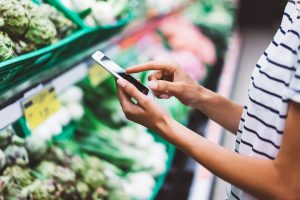Pandemic changes in how we purchase food could be permanent
By Daniel Grant FarmWeek — March 22, 2022
A recent survey shows consumers’ preferred method of shopping is a combination of in store and online. These shopping trends are expected to continue. (Illinois Farm Bureau file photo)
The pandemic greatly accelerated online food purchases and created a new revenue stream for many restaurants in the form of curbside sales.
And now, even as masks come off with the lifting of mandates at many locations around the U.S., those trends in the food industry are expected to continue or even grow.
Andrew Harig, vice president of tax, trade, sustainability and policy for the Food Industry Association, and Hudson Riehle, of the National Restaurant Association, discussed food industry trends during USDA’s 98th annual Ag Outlook Forum.
“2021 was one of the most difficult years we’ve faced, even more so than 2020, with COVID, supply chain disruptions and inflation that carried into 2022,” Harig said.
“Consumers are being remarkably resilient. We’ve seen a big rise in online shopping, but a real anxiousness to get back to stores to select items for themselves.”
A recent survey shows consumers’ preferred method of shopping is a combination of in-store and online at 35 percent, followed by 34 percent in-store only and 28 percent online. The remaining 3 percent reported no preference.
These shopping trends are expected to continue with nearly two-thirds of consumers now purchasing at least a portion of their food online. The top influencers of food purchases are good value, product quality and overall price, Harig reported.
Meanwhile, the restaurant industry bounced back last year from tremendous losses in 2020, but nowhere near pre-pandemic levels. Restaurant sales totaled just $659 billion in 2020 (down from a forecast entering the year of $899 billion) before recovering to around $800 billion last year.
“There has been some recovery from the depths of the pandemic,” Riehle said. “And (sales) continue to improve, but it looks to be another year of transition.”
The food service industry continues to deal with a shift in sales from in-house to takeout, high food and transportation costs, and a lack of available workers. Wholesale food price inflation jumped 7.8 percent last year.
Only six states had as many or more food service workers at the end of February compared to pre-pandemic levels, according to Riehle. In Illinois, the number of food service workers is still down about 12 percent compared to pre-pandemic levels.
“On-premises restaurant dining is still down significantly,” Riehle said. “Drive-through, curbside and delivery has been a lifeline to the industry.”
Looking ahead, Riehle foresees more streamlining of menus in restaurants to adjust for supply issues along with the use of more technology and more online orders.
“It’s going to be a while before we can make adjustments to get the supply side caught up,” Harig said. “Really, for the first time, I think a lot of consumers are beginning to realize just how complex the supply chain can be.”
And the situation is even more complex now due to drought in South America and the Russian invasion of Ukraine. Those two countries account for about 29 percent of global wheat exports.
“The inflation story is really an energy and food price spike story,” Jacob Shapiro, chief strategist for Perch Perspectives, told FarmWeek.
In Europe, for instance, energy prices were up more than 28 percent year over year and food prices increased more than 5 percent while other items increased just 2.3 percent, Shapiro noted.
“The Russia-Ukraine war will only exacerbate that,” he said. “Unless (the two sides) reach a settlement soon, expect higher inflation, especially driven by energy and food prices.”
This story was distributed through a cooperative project between Illinois Farm Bureau and the Illinois Press Association. For more food and farming news, visit FarmWeekNow.com.



